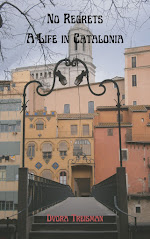In the middle ages, the Camino de Santiago was the most important of the three main pilgrimages of the Christian world. People made the pilgrimage from France, England, Holland, Germany, Poland, and other countries. Making a pilgrimage was one of the most important things you could do to save your immortal soul in medieval times, and I’ve read that half the population of Europe could be found on the Camino at any given time.
Known in English as the Way of Saint James, the Camino is made up of many tributaries that lead in to the main path. Throughout Europe, people walked out their front doors and started walking. They made their way to the nearest of the main points from where an official path would lead to other paths that eventually led to the cathedral in Santiago de Compostela in the northern Spanish province of Galicia, where it is said the bones of Saint James are buried. Wherever they started, people walking from the north would have to pass through France (where it is known as the Chemin Saint Jacques) to reach Spain. In France, the main starting points were Arles, Le Pug, Paris, Vézelay, Cluny, and, closer to the Spanish border, Roncesvalles, and Saint-Jean-Pied-de-Port. Along the way they would stop at churches where their pilgrimage would be authenticated, and they would be put up in monasteries or local hostels.
Walking the Camino has made a comeback in modern times. In 1985, about 800 people walked enough sections of the Camino to be counted. In 2018 over 300,000 were counted. In 1994 Shirley Maclaine walked and then wrote a book about it. Some people walk it as a pilgrimage, a spiritual quest, others as a way to clear one’s head from the noise of modern life, or a hike, a personal challenge, or an adventure. Some do it because it has been there for over a thousand years and it is a way to join into an historic, collective action. The Camino was made an UNESCO World Heritage site in 1993.
The scallop shell is the symbol of the Camino. During medieval times the scallop shell was proof of completion of the Camino. Now it is worn by those making the pilgrimage as they walk the path. It also appears on signposts and pavement tiles marking the way.
There are also paths from the south that lead through Spain. There are paths from Madrid and Barcelona, and others that are less known and that begin in Catalonia. One of those other ones passes through Figueres.
I walk my dog on the Camino de Santiago, known in Catalan as the Cami de Sant Jaume. With Santiago somewhere behind me, I take the path in the other direction, from Figueres through farmland to the nearby village of Vilabertran.
The 11th century Romanesque church and cloister of Santa Maria was once an important religious center and a stopover for pilgrims. They would have come down through the Coll de Panissars, on what was once the Via Augusta going from Rome to Cadis, near the present day Le Perthus. Or they would have come by boat to Port de la Selva, visited the important monastery at San Pere de Roda, and arrived at Vilabertran from the east. The church still holds services and is also home to the annual summer Schubertiada festival.


























